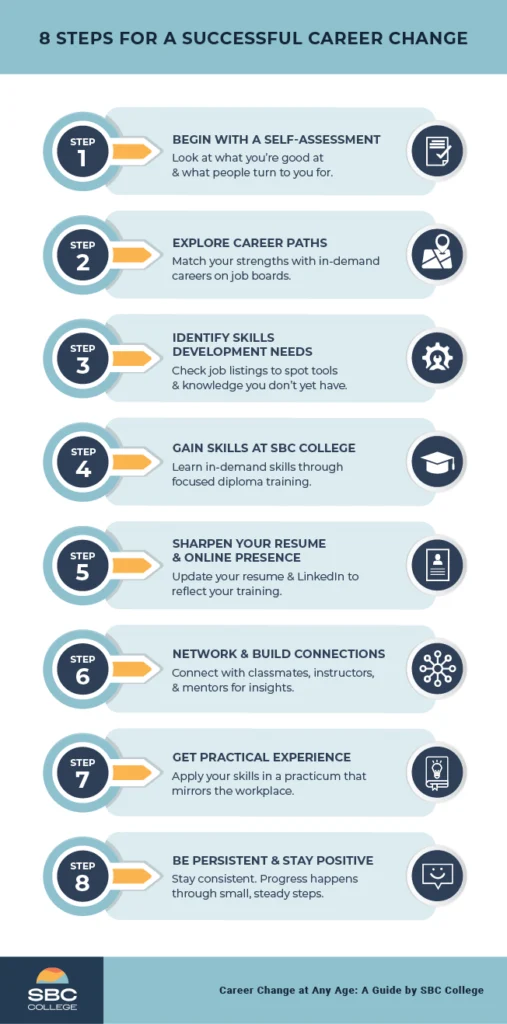Table of Contents
Changing careers is a big decision, whether you are in your thirties, forties, or fifties. It can feel like starting over, but the truth is you are not beginning from scratch. You are moving forward with experience and transferable skills.
Adult education helps you build new skills, explore different paths, and take steady steps toward a career change.
This article shows how SBC College supports that job transition with training, guidance, and a path toward long-term career satisfaction.
Listen to: Career Change at Any Age: A Guide by SBC College
Understanding Today’s Career Landscape
The idea of staying in one job for life no longer fits the way most people work today. Many adults are rethinking their goals and exploring new directions that align better with their strengths and interests. Career change trends reflect this shift, as more people look for roles that offer growth, balance, or a better match for their current priorities.
The job market continues to expand in areas like healthcare, administration, and technology. Roles such as health care aide, accounting clerk, administrative assistant, and network technician are growing and often serve as strong entry points for those who bring in-demand skills to the table.
8 Steps to Your Career Change
Choosing the right career takes planning, especially when you’re building on experience you’ve already gained.
This step-by-step approach guides you through the career change process with actions you can take at every stage.
These career transition steps show the choices you can make, the tools that support you, and how SBC College helps you move toward a new direction that fits your goals.
Step 1 – Begin with a Self-Assessment
Forget job titles for a moment and focus on self-assessment. What do people usually come to you for? Maybe you’re the Wi-Fi fixer in the house. Maybe you’re the planner, always organizing get-togethers. Or maybe you’ve helped a family member or a relative with mobility or daily routines? These are early signs of where your strengths lie.
Skills identification starts by looking at these patterns. Instead of only asking “What do I like?” ask “What problems do I naturally solve?” and “What do people often ask me for help with?” These questions can give you better insight than a personality quiz.
If you are unsure how your strengths connect to career goals, an advisor at SBC College can help you explore paths that match your skills and experience.
Step 2 – Explore Career Paths
Once you’ve identified your strengths, use resources like Job Bank and ALIS to explore potential career options. Focus on what the work actually involves rather than just the title.
For example, a systems administrator could be a good match if you’re comfortable troubleshooting and organizing digital systems. Or consider an accounting technician: If you’re someone who keeps track of expenses, organizes receipts, or helps others with budgeting, you might already be drawn to the kind of detail-oriented work accounting involves.
Pick two careers that interest you and compare them using tools like Job Bank. Look at salary ranges, job market trends, and education requirements in your province. This approach helps you assess practical details like job availability and long-term growth potential.
To get a better sense of what these roles look like in practice, you can talk to your instructor at SBC College. Their insights can support your career research by helping you understand the day-to-day responsibilities and what employers look for when hiring in that field.
Step 3 – Identify Skills Development Needs
Look closely at what employers are asking for. In tech, that could include knowing how to configure firewalls or work with cloud platforms like Microsoft Azure. In healthcare support, you may need training in personal care procedures or experience with electronic medical systems, depending on the position. Administration roles often mention Outlook, QuickBooks, Excel, and the ability to carry out day-to-day office procedures.
If a job description involves any unfamiliar terms, don’t count yourself out. Make a list of what you don’t recognize and look for adult education training programs that address your skills gap. This approach helps you focus your learning instead of guessing what might be useful.
Step 4 – Gain Skills at SBC College
SBC College diploma programs focus on skills training that matches what employers need today. Students can choose online learning or on-campus options, making it easier to build practical skills in a way that fits their schedule.
Instructors support that learning by drawing from their own experience and showing how each concept applies in practical settings. The combination of focused coursework and applied learning prepares you to meet the expectations of your chosen field.
Step 5 – Sharpen Your Resume & Online Presence
As you build new skills, your resume should grow too. Highlight your training, relevant coursework, and any tools or software you’ve learned to use. Be specific—mention the systems you’ve worked with, whether it’s accounting platforms, scheduling tools, or cloud services.
The diploma programs at SBC College include career support, such as resume writing sessions, mock interviews, and advice on what to wear to job interviews. These resources give you a chance to practice, get feedback, and walk into interviews feeling confident.
Online visibility matters, too. A well-organized LinkedIn profile shows employers what you’ve been working toward. Include a short summary that reflects your goals, update your job titles to match your new direction, and list the credentials you’ve earned. This helps recruiters and hiring managers see how your background connects with the roles you’re targeting.
Step 6 – Network & Build Connections

A good way to learn about a new career is by networking with people who are already working in it.
During your diploma training, you may meet classmates who have experience in the field, instructors who know what employers expect, or supervisors during your practicum. You can set up informational interviews to ask how they got started, what skills matter most on the job, and what they wish they had known earlier. These conversations can give you career advice, help you avoid common mistakes, and even lead to job opportunities.
Connecting with SBC College alumni is another way to make career connections and hear firsthand about different career paths.
Step 7 – Get Practical Experience
SBC College practicums, as part of your diploma, give you the opportunity to apply your training in a professional setting. You’ll take part in day-to-day work, observe how teams operate, and build practical experience that reflects the role you’re aiming for.
This hands-on learning also adds to your resume and gives you industry experience to talk about during interviews, showing how your skills transfer to the workplace.
Step 8 – Be Persistent & Stay Positive
Changing careers takes time. Some days will feel exciting. Other days may feel uncertain. That is normal. Focus on each small step. Completing a course, updating your resume, reaching out to someone in your target field, or using SBC College support services are all signs of progress. Keep going. These small steps build momentum.
“Career perseverance is about being consistent even when the finish line feels far away. Focus on the skills you are building, the connections you are making, and the opportunities you are preparing for. Every effort brings you closer to a career that fits your goals.”
Janice T., SBC College instructor for Communications and Career Strategies coursework, emphasizes that career change is about staying focused, using the support around you, and trusting the steps you are taking.

Why SBC for Your Career Change?
Career change feels more achievable when you hear from others who’ve done it. At SBC College, many students start with practical goals and leave with new opportunities, skills, and direction.
Tanya K., an SBC College graduate, trained to become an administrative assistant through an accelerated diploma. She built skills in communication, customer service, office software, and accounting, leading to a full-time job offer that matched her career goals.
“This position is exactly what I had in mind as the first step into business and office administration. The training I received helped me feel ready to take it on, and I’m confident I made the right decision choosing SBC.”
Jessica D. completed her diploma in the Legal Assistant program and received two job offers shortly after graduation.
“I’m happy with how supported I felt throughout the process. Applying for jobs and preparing for interviews felt less overwhelming because of the guidance I received. I couldn’t be more excited to begin this next chapter.”
These alumni stories show what can happen when focused training is paired with personal commitment and support.
To take your next step toward a new career, contact an admissions advisor today. You’ll get clear information on programs, learn how the training aligns with your goals, and see what kind of support is in place as you make your career switch.
Career Change FAQs
What is the best way to change careers at any age?
The best way to change careers is by pursuing a diploma program at a career college. Focused training gives you the skills employers are looking for and helps you move toward roles with stronger opportunities for growth.
How do I know if it’s time for a career change?
You might be ready for a career change if your current work no longer feels fulfilling, your interests have shifted, or you see a stronger fit between your strengths and roles in other fields. Paying attention to what motivates you, what drains you, and what you look forward to can help you recognize when it is time to explore new opportunities.
What are the first steps to making a career change?
Start with a self-assessment to understand what skills and strengths you already have. Then research the in-demand careers in Canada that align with those strengths. From there, focus on the skills training needed, refresh your resume and LinkedIn profile, and begin networking with people in the field you want to move into.
Is it ever too late to start a new career at any stage in life?
No, it is not too late. Career changers at any age often bring valuable experience, problem-solving skills, and a strong sense of direction that employers appreciate. Adult education programs help you build new skills quickly, making it possible to transition into growing fields like healthcare, administration, or technology within a year.
What skills are most important for a career change?
Adaptability, communication, digital literacy, organization, and the ability to learn new systems are important across many industries. Specific technical skills, such as proficiency in accounting software, healthcare procedures, cloud platforms, or administrative tools, will depend on the field you are moving into.
How long does it take to successfully change careers?
You can start a new career in under a year with a diploma program in an in-demand field. At SBC College, most programs take 8 to 12 months and focus on building the skills and experience employers are looking for.






